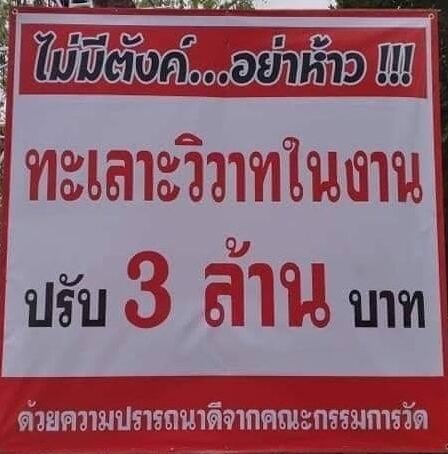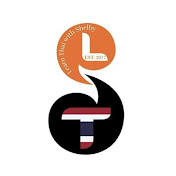Solidarity in Thai
Humor in Thai
PRACTICAL IDEAS AND RESOURCES
Resources in this section curated by: Johanna Lyon, Cathy Lee, Tung Tuaynak, Jermayne Tuckta, and Ken Ezaki Ronquillo

วิธีการเป็นคนตลก How to be Funny in Thai | Blog Post
This is a blog showing how to be funny as in Thai context. Humors are perceived differently in different cultures; however, this blog presents approaches suggesting how to be humorous. There are three core considerations recommended: fostering a sense of humor, developing a funny persona and keeping on finding new inspirations.

Funny Thai Words Translated to English That'll Make You Laugh | Article
This resource displays funny Thai words when translated into English. It is fun to know how English speakers react to Thai words that sound and have meanings like funny English words. It is beneficial for those who learn Thai and get more jokes as people play with the translation.

Ta Lok Hok Chak | YouTube Video
This is a TV program which is a kind of comedy. There are various humorous scenarios. In each scenario, the characters will act and present the most recent and trendy jokes that most Thai natives will consider funny. I encourage those who want to learn what Thai people generally find funny to learn from this program.

Imaginary Heartbreak | Tweet

This is a Thai joke. The word “ทิพย์” is typically used for describing how gods in heaven live, which is imaginary. Now, the word “อกหักทิพย์” is used to describe an imaginary heart-break to be sarcastic to those single people who feel heart-broken despite having no experience of being in a relationship at all.

Temple Sign | Signage

This is the sign post located in the temple where it happens to be ironically a place for a concert instead of a peaceful place. Using the word “ห้าว” to address the warning to specific group which is gangsters who seem to be habitually cause the disturbance. The fine will be 3 million baht, so if you don’t have that much money, don’t dare to cause any problem in the concert.

Learn Thai from memes | YouTube Video
This is the channel to teach Thai language in everyday life. This particularly chosen video is about memes to help understanding Thai language and cultures. It is a salient resource to help understand the humor of Thai people.

Bike for teacher | Meme

This is a Thai meme showing the sarcastic warning from the teacher to the students to submit the assignments as soon as possible before getting an F. The idea of “Bike for Teacher” is originally inspired by the national project on the King’s birthday, “Bike for Dad”. The word bike in Thai is “ปั่น” which could also be used in the sense of rushing to finish something. So, the teacher on Facebook try to use this meme to pressure the students to rush to submit the assignments as soon as possible; otherwise, they will receive an F. The fact that Miley Cyrus photos are displayed in the meme clearly shows that Thai memes have been influenced by the American media.

Coronavirus Meme | Image

This is a very interesting meme about the current and trendy situations in Thailand. Due to the Coronavirus outbreak in Thailand, the Thai government and royal soldiers help, with bare hand packing the hygienic masks to sell to the Thai people. It is obviously ironic because it looks not hygienic at all with the bare hands. Therefore, the idea of “hygienic masks which are not hygienic at all” sounds like the typical song titles of Getsunova band that often presents the ironic sense in it. It is super hilarious!
ACADEMIC RESOURCES ON HUMOR IN THAI
Resources in this section curated by: Johanna Lyon, Cathy Lee, Tung Tuaynak, Jermayne Tuckta, and Ken Ezaki Ronquillo
Forman, Ross. (2011). Humorous Language Play in a Thai EFL Classroom. Applied Linguistics. 32. 541-565. 10.1093/applin/amr022.
The relationship between creativity, play, and language learning has been of increasing interest over the past decade, but the role of humour itself in SLL remains significantly under-explored. The present study examines humorous language play initiated by a bilingual EFL teacher and taken up by his post-beginner students in a Thai university setting. A framework of verbal art is adopted in order to locate this use of humour in relation to both language play and to creativity more broadly. Textual analysis draws upon the psychological notion of incongruity, as well as upon Bakhtin’s ‘carnival’.
The verbal humour observed in this class is identified as having two foci: linguistic, relating to word-play, and discursive, relating to social positioning. For students, benefits to learning are recorded in affective, sociocultural and linguistic dimensions. In consideration of the teacher’s role, it is suggested that the capacity of humour to ‘unsettle’ requires careful handling.
Jaroenkitboworn, Kandaporn. (2015). Failed L2 Humor: A Case Study of EFL Thai Learners. 10.13140/RG.2.1.3468.9764.
This research explored how EFL Thai learners failed to comprehend and appreciate English jokes. Participants in this study were 16 undergraduate Thai students. They were required to read 22 English jokes and reported their understanding and appreciation of each joke. After they finished the reading test, each student answered a questionnaire and then he or she was interviewed to answer some more open-ended questions and also to clarify some of his or her unclear answers in the questionnaire. The study results showed that there were three types of relations between comprehension and appreciation of the jokes which concern their failed humor. These are (1) incomprehension and no appreciation, (2) incomplete comprehension but appreciation, and (3) complete comprehension but no appreciation. Their failures can be classified into 4 types: failure to understand linguistic ambiguity, failure to understand socioculture, failure to process the joke text in the same way as the native do, and failure to join in the non-bona fide mode which is a mode of communication that differs from the normal mode that people are supposed to commit themselves to the truth. More importantly, the students in this study also revealed in the interview several interesting viewpoints toward English native cultures.
This study is potentially relevant to our topic since jokes could be effective in helping the students learn at ease. The classroom at times appears to be learnable when comprehensible humors are incorporated properly. However, if the jokes are addressed in the class, and the students do not understand the pragmatic meaning because of the factors mentioned, it might cause confusion and hinder the students’ learning. To read this study, teachers and learners will be aware of the possible factors that might affect the L2 humor failure, and they can hopefully improve the more suitable materials for L2 pragmatic learning.
Wangsomchok, Chantima. (2016). A Linguistic Strategies to Express Humor in Thai Context. International Journal of Social Science and Humanity. 6. 462-465. 10.7763/IJSSH.2016.V6.691.
The main purpose of this research is to explore the ways that humor is expressed, taking into account linguistic strategies used. Speech act categorization, cooperative principle and implicatures are the frameworks applied in this research. The source of data for analysis is five Thai situation comedies. From a speech-act theoretical perspective, the findings demonstrate that there are six categories of humor-related speech acts: expressing condescension, boasting, blaming, threatening, satire and teasing. These strategies, on the whole, indicate that humor in Thai situation comedies is closely associated with an emotion of superiority and aggression created by the speaker.
The study also shows that humor can be carried out by non-observance of the cooperative principle in two ways: violating a maxim and flouting a maxim. In the first case, the maxim was found to have been flouted and revealed instances of conversational implicatures. In the second case, furthermore, conversational implicature was generated, but as a result of maxim violation. What is peculiar to the findings of the study is that humor can be brought about by a speaker intentionally telling a lie to confuse the hearer or audience. Later, when the speaker reveals that he/she him/herself is held responsible for a maxim violation, laughter and thus humor ensue. Aside from this, there is only one example of humor-related conventional implicatures found.
